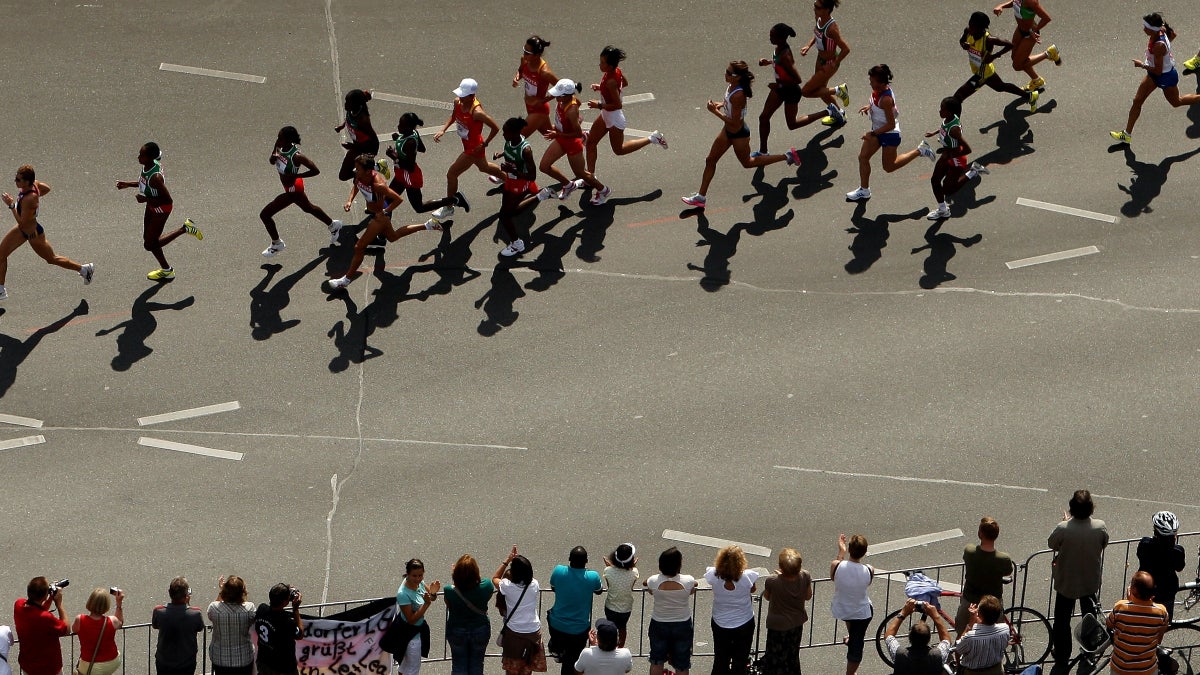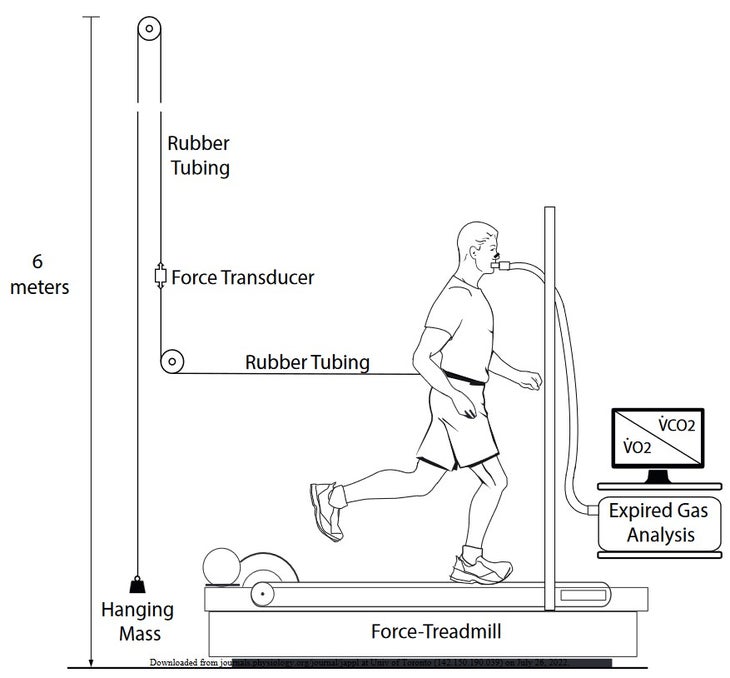
The numbers have been out there for decades. Drafting behind another runner, the data suggests, could save an elite marathoner as much as six minutes. It’s scarcely believable—which is probably why most of us don’t really believe it. After all, the most famous and influential study on drafting in runners, published back in 1970 by pioneering Everest physiologist Griffith Pugh, was based on a wind-tunnel experiment with a grand total of one subject.
Eliud Kipchoge’s sub-two-hour marathon attempts in 2017 and 2019, which featured rotating casts of pacemakers in carefully choreographed formations, made drafting a topic of conversation among runners. But estimating the resulting time savings remained controversial, especially since subsequent studies after Pugh produced widely varying results and often used convenient but inaccurate shortcuts to estimate the effects of a given amount of air resistance on energy consumption and running speed.
Enter a new study from Edson Soares da Silva of Universidade Federal do Rio Grande do Sul in Brazil, Rodger Kram of the University of Colorado, and Wouter Hoogkamer of the University of Massachusetts, Amherst, published in the Journal of Applied Physiology. It aims to provide definitive answers about the effects of wind resistance on marathon running, and it offers some surprises along the way. Some people are better than others at running into the wind, it turns out, and five-hour marathoners save roughly the same amount of time as Kipchoge does by drafting.
The new study provides the missing link to connect two existing bodies of research. Previous studies have used computational fluid dynamics to figure out how much force the air exerts on you. As I described a couple of years ago, those studies suggest that running into still air at elite marathon pace exerts a drag force of about 8 Newtons, and drafting directly behind someone else drops that to about 4 N. A medium-sized apple weighs about 1 N, so it’s like being tugged backward by the weight of either a big or a small bag of apples.
That’s interesting, but knowing the forces involved doesn’t directly tell us how much faster or slower we’ll go. If we knew how much extra energy we burned due to air resistance, and how much of that energy we saved by drafting, then we could harness earlier research from University of British Columbia researcher Shalaya Kipp (working with Kram and Hoogkamer) that linked energy savings to running speeds. To connect those two ideas, you need to know how much extra energy you burn when being pulled back by a small force on the order of 4 to 8 N. That’s what da Silva’s study measures.
The set-up is shown in the diagram below. The subject runs on a treadmill while breathing into a mask that measures energy consumption, and is tugged backward by rubber tubing connected via pulleys to a hanging weight that exerts the desired force—in this case 0, 4, or 8 N, since that’s the range of aerodynamic drag forces seen in the computational fluid dynamic studies of runners drafting.

The main result is obvious: bigger drag forces make you burn more energy. The question is by how much. Across three testing speeds between eight and six minutes per mile, they found that energy consumption increased by about 6 percent for every increase of 1 percent of body weight in the force pulling them backwards.
For Eliud Kipchoge, weighing 115 pounds and running two-hour-marathon pace with no pacers, the drag force is 1.39 percent of his body weight, which means he’s burning 7.8 percent more energy than he would with absolutely perfect drafting. Plug that number into Kipp’s equations, and you find that perfect drafting would save him 6:28 over the course of a marathon. For women’s world-record holder Brigid Kosgei, running at a slightly slower pace, the savings would be a still-massive 5:58.
The first thing to note is that Pugh’s single-subject study from a half-century ago, which produced those seemingly improbable predictions of six-minute savings, turns out to be pretty much right on the money. That was a lucky break, though. The average energy cost in the new study was 6 percent, but the range among the 12 subjects was 4.2 to 8.1 percent. In other words, some subjects pay twice as much as others for running into the wind, and consequently benefit roughly twice as much from drafting. That’s a startling finding.
The researchers used a force-sensing treadmill to measure the runners’ footstrikes, and saw that greater drag pulling them backwards reduced their horizontal braking forces upon landing and increased their forward propulsive forces upon push-off. But they didn’t find any connection between these individual biomechanical variables and who benefited the most from drafting. This seems like a tempting target for future research, because if you can figure out why some people are so much better at dealing with air resistance—and figure out how to teach others to do it—that’s the energetic equivalent of giving yourself a pair of imaginary supershoes.
In reality, drafting isn’t perfect. The only way Kipchoge would gain 6:28 would be if he were running in a vacuum, which would eliminate 100 percent of the drag force. Computational fluid dynamics studies have tested various drafting formations to determine how much of the drag force they block. The simplest example considered by da Silva and his colleagues is three pacers running abreast, with the racer close behind the middle one. That blocks 57.3 percent of the drag force, which would translate into a 3:42 savings for Kipchoge. The most effective configuration is a seven-person inverted arrow similar to the one used by Kipchoge in his sub-two run in Vienna in 2019, which blocks 85 percent of the drag force, corresponding to a savings of 5:29.
Looking at these numbers, you can’t help doing the math on Kipchoge’s Vienna run: 1:59:40 plus 5:29 equals 2:05:09 for a solo marathon. That may sound underwhelming, but only because we tend to forget that virtually all top-level marathons are now run with some form of drafting at least during the first half of the race, Hoogkamer points out. Even though more than 70 men have run sub-2:05 marathons, it’s quite possible that no one has ever done it without any drafting at all.
In practice, of course, the benefits will almost always be smaller than these best-case calculations. It’s very hard to stay in perfect drafting position, so runners are likely to drift in and out of shelter throughout a race—particularly if it’s a competitive race where more than one runner wants to be in the best spot. And it’s even possible that drafting too well will rob you of the cooling effects of a breeze in your face, causing you to overheat a little sooner than you otherwise would.
Still, the numbers are big enough that even imperfect drafting seems like a worthwhile endeavor—and not just for the likes of Eliud Kipchoge and Brigid Kosgei. It’s true that the effects of drafting are much greater at higher speeds, but we mortals are out there for much longer and have more time to accumulate the benefits. According to da Silva’s calculations, a typical 5’9”, 145-pound midpacker drafting behind the simplest three-person formation would save 3:08 over the course of a three-hour marathon, 2:59 over a four-hour marathon, and 3:00 over a five-hour marathon. Kipchoge’s and Kosgei’s savings, at 3:42 and 3:25 respectively, are in the same ballpark despite the huge differences in speed. In all honesty, these numbers are still so big that they’re hard to believe—but the evidence is now much stronger. If you’re looking for three minutes in your next marathon, it’s there for the taking.
For more Sweat Science, join me on Twitter and Facebook, sign up for the email newsletter, and check out my book Endure: Mind, Body, and the Curiously Elastic Limits of Human Performance.
The post Drafting Isn’t Just for Elite Marathoners appeared first on Outside Online.

